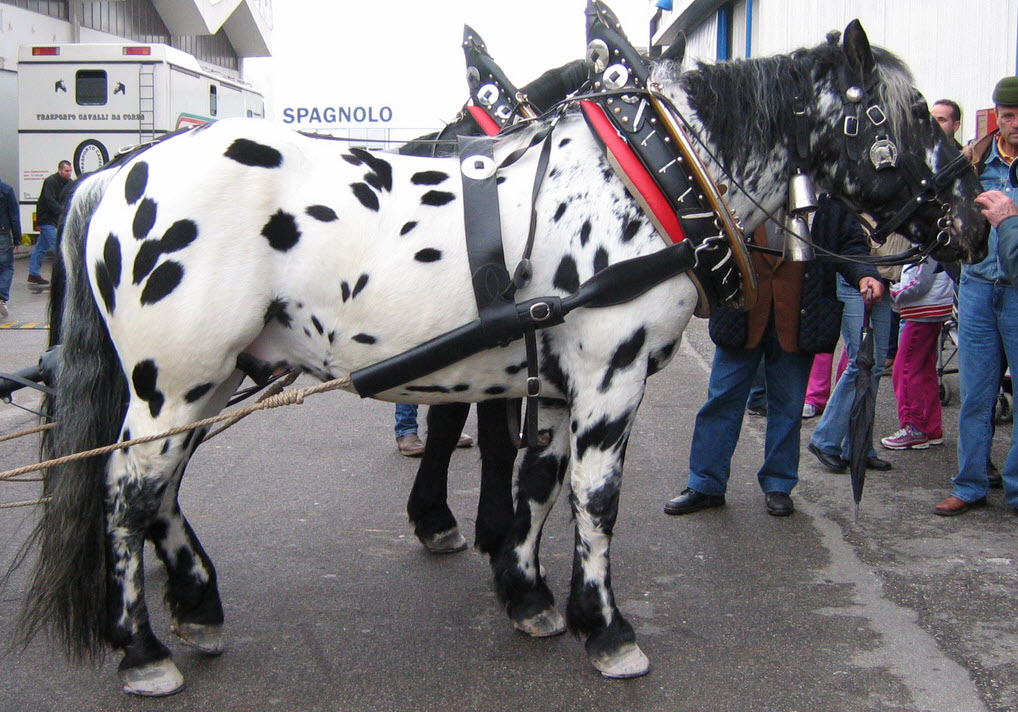Other spotted horse breeds
The Appaloosa is an United States horse breed best known for its colourful spotted coat pattern, but it is definitely not the only spotted horse breed in the world, and the history of spotted horses goes back very far. There are even prehistoric Euroasian cave paintings that depict horses with leopard-spotting and this may actually reflect a type of a wild horses that existed when these paintings were made.
When it comes to domesticated horses, we see horses with leopard spotting in surviving art from both Ancient Greece, Ancient Persia and Ancient China´s Han dynasty.
In the mid-1700s, leopard-spotted horses became highly fashionable among European royalty and aristocracy, and this boosted demand for horses looking this way.
Examples of modern-day horse breeds with leopard complex spotting are the Danish Knabstrupper and the Alpine Noriker.
Knabstrupper
The Knapstrupper, also known as the Knabstrup horse, is a Danish horse breed where the coat patterns range from solid to full leopard-spotted coat, with many variants in between. Just as for the Appaloosa horse, the spotted coat is the result of the leopard complex genetic mechanism.
The breed generally has either warmblood or Baroque horse conformation.
Today, Knabstrupper breeders are chiefly found in Europe, North America and Oceania. In Europe, most breeders are found in north- and central Europe, e.g. in Denmark, Sweden, Norway, the Netherlands, the United Kingdom, Germany, Switzerland, and the Czech Republic.
Knabstruppers tend to do well in show jumping and dressage, and are also popular for general riding and as carriage horses. Some work as circus or show horses.
Size
Most individuals are in the 15.2-16 h range, but pony-sized (smaller than 14.2 h) Knabstruppers also exist.
History
This breed was established in Denmark in the early 1800s. In 1812, a chestnut mare with leopard complex blanket markings was bred to a solid-coloured stallion, and the resulting colt displayed a very dramatic spotting. The mare and her son were bred to other horses to establish the Knabstrupper breed, which became very popular due to its striking appearance.
Link to the Appaloosa
In 1971, three Appaloosa stallions were imported to Denmark to add new blood to the Knabstrupper breed.
Noriker
The Noriker horse is a moderately heavy draught horse breed from the central Alpine region. Historically, this horse has been very important for transports in the demanding Alpine terrain. It was called Pinzgauer until the late 1800s and is still sometimes referred to as the Norico-Pinzgauer horse.

The Noriker comes in many different colour varieties, including leopard spotted. For breeders seeking to promote the leopard-spotted version, the sire-line Elmar is especially important.
As the Noriker was used as a draft horse in the Alps, it is both strong, power and agile, and can handle itself well in Alpine terrain. It is sure-footed, with a low centre of gravity and a good sense of balance.
Size
The normal size is between 15.2 and 16.0 hands at the withers.
There used to be a smaller sub-type available called the Abtenauer, but the Abtenauers has now been absorbed into the main Noriker population. Abtenauers were usually 14.2 – 15.0 hands and utilized to transport wood over steep terrain. They were not leopard-spotted.
History
The Noriker horse is associated with the Grosslockner – the highest mountain in the Austrian Alps. The name of the breed used to be Pinzgauer, and Pinzgauer is a region located not far from Salzburg.
The Pinzgauer was very important for transportation of goods in the Alps. Among other things, it would bring salt, gold and iron from Salzburg to Italy, and return with wine and spices.
The name of the breed was changed to Noriker in the late 1800s, when the region was going through a period of Romanophilia. During the Roman Empire, Grosslockner was a part of a Roman province named Noricum, hence the name Noriker.
The studbook for the Noriker was closed in 1903.
This article was last updated on: September 19, 2022